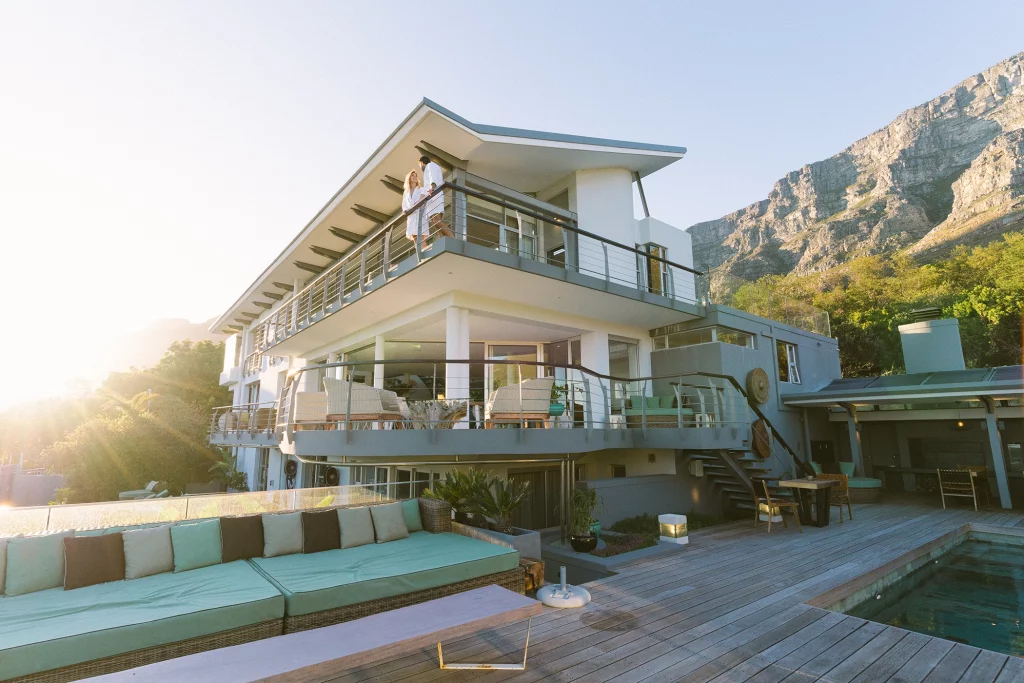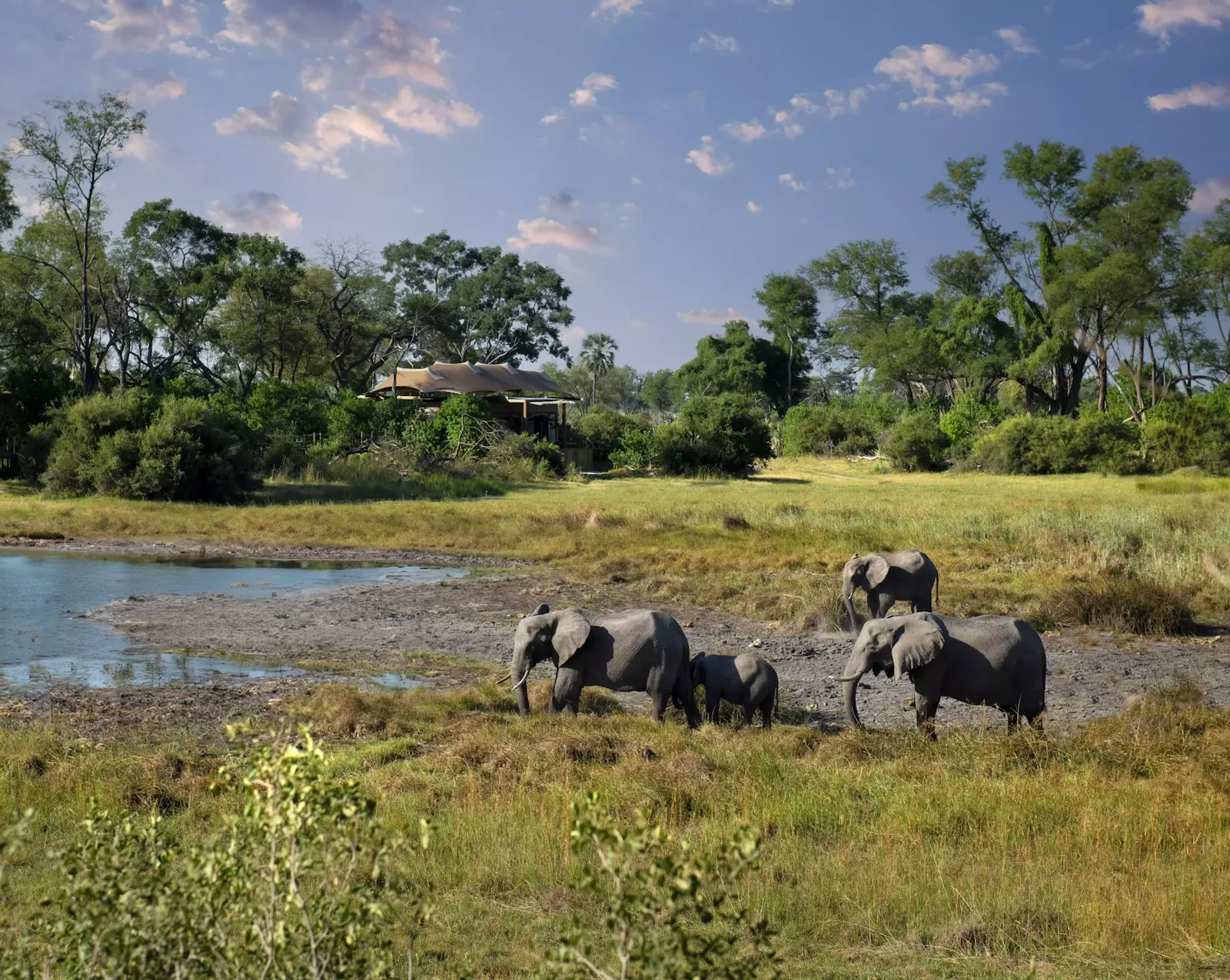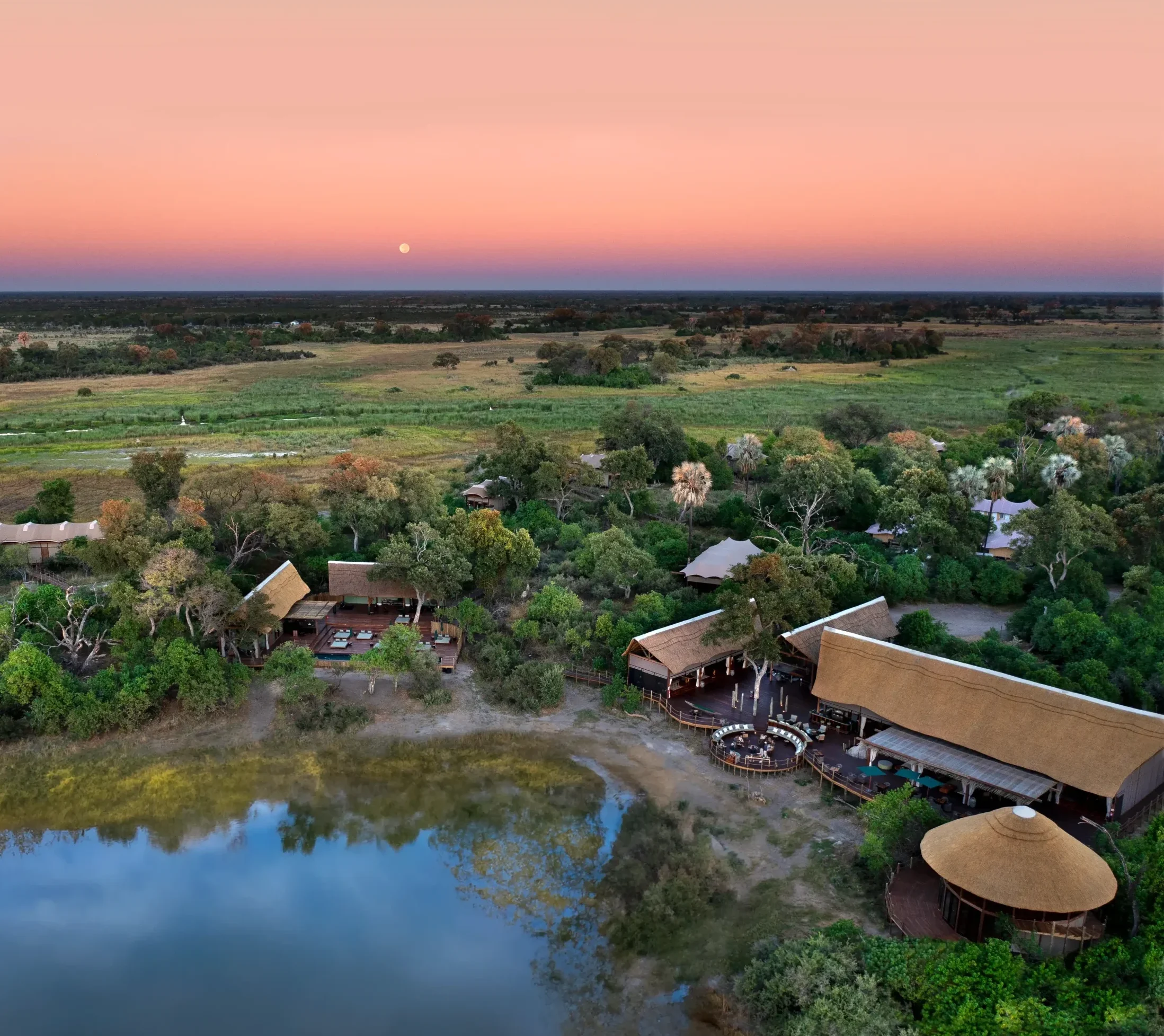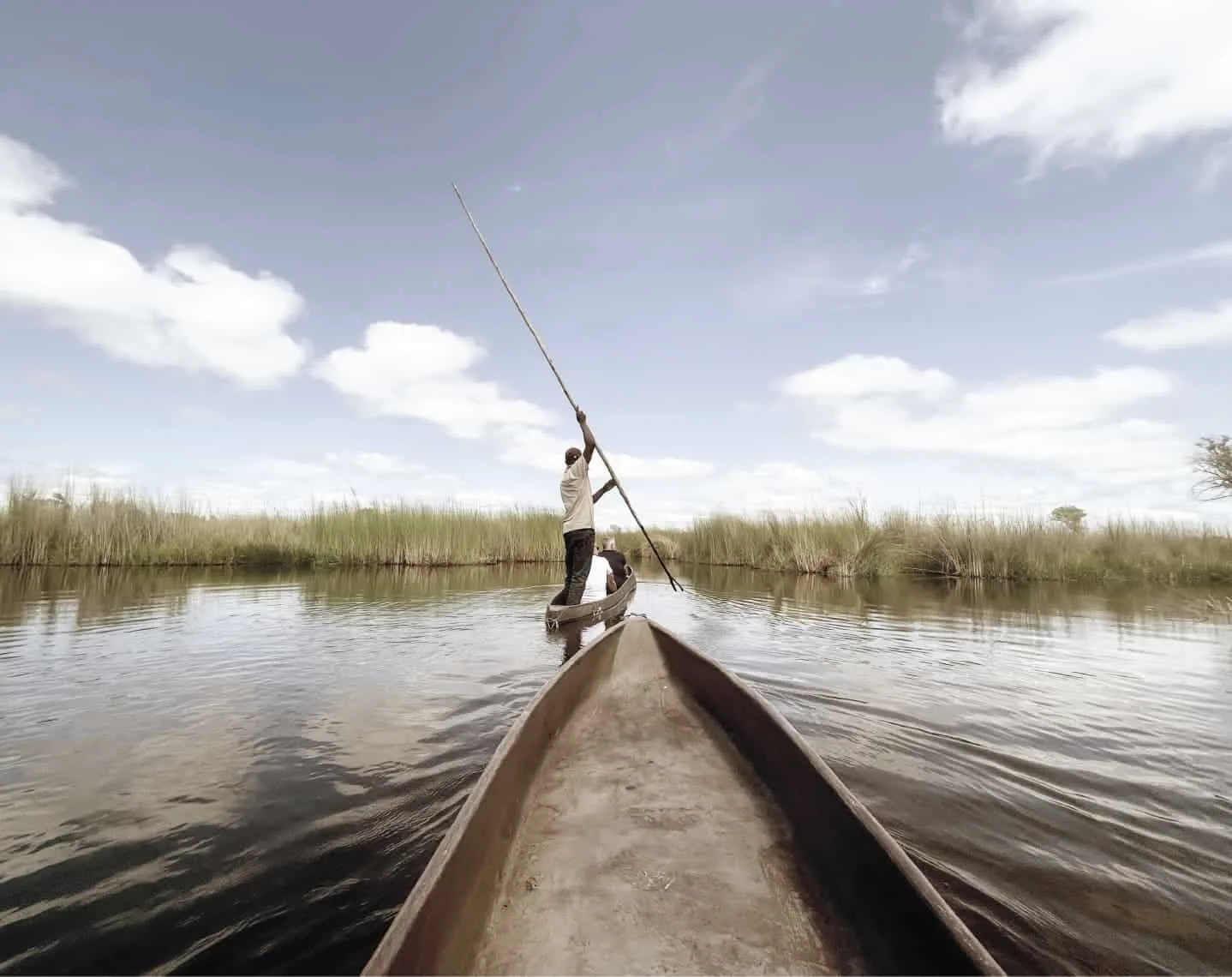Picture this: A mirror-still channel framed by papyrus. A heron lifts off with barely a sound. Your mokoro, a traditional dugout canoe, glides silently forward, poling past lilies and startled antelope. This isn’t just a safari. It’s a return to rhythm, to slowness, to the soul of Botswana’s Okavango Delta.
Welcome to the timeless magic of the mokoro safari, and to Atzaró Okavango, where this ancient form of exploration meets the finest in luxury and immersive wildlife experiences.

What Is a Mokoro Safari?
A mokoro safari is the most traditional and low-impact way to explore the Delta’s waterways. Once carved from sausage trees and now often made from eco-composites, the mokoro is propelled by a poler standing at the rear, gently steering with a long ngashi pole.
Unlike a game drive or even a walking safari, the mokoro journey is about intimacy. You float within inches of the water, ears tuned to the rustle of reeds, eyes peeled for the flick of a sitatunga’s ears or the shimmer of a dragonfly’s wing.
“As someone who’s glided through those early morning channels, I can tell you—there’s a moment where the only sound is the tap of the pole and the echo of your own breath. That’s when the Delta speaks.” — Craig Howes, Editor of African Safari Mag
It’s not just about what you see, it’s how you feel. Time slows, perspective shifts. You become part of the ecosystem, not just an observer of it.

Why the Okavango Delta Is the Ultimate Mokoro Destination
Declared a UNESCO World Heritage Site, the Okavango Delta is one of Earth’s last true wildernesses — a seasonal floodplain where crystal-clear water fans out over 15,000 square kilometres of palm islands, lagoons, and lush channels. And it’s this unique landscape that makes the mokoro experience unlike anywhere else in Africa.
Unmatched silence and serenity: No engines. Just the sound of your poler’s pole tapping the riverbed, and the wind in the reeds.
Rich biodiversity: Spot reed frogs, painted reed crakes, malachite kingfishers, and elephant herds that wade chest-deep through water.
Access to untouched places: Mokoros reach areas that are impossible to explore by vehicle — hidden lagoons and narrow, game-rich backwaters.
Atzaró Okavango’s remote private concession offers exclusive access to some of the Delta’s most pristine mokoro routes — far from the crowds, where only the fish eagles and lechwe might witness your passage.

What to Expect on a Mokoro Safari at Atzaró Okavango
Here, at the heart of the Delta, a mokoro safari becomes an elevated, soul-rich experience — expertly guided, deeply immersive, and wrapped in quiet luxury.
🌿 Afternoon Drifts Through the Reeds
Mokoro safaris typically begin late afternoon, when the water is glassy and the air is cool. After High Tea on the deck of the main lodge, your guide will escort you to the launch point. Expect:
A gentle 1–2 hour journey through winding channels
Polers who are not just navigators but storytellers , local men and woman whose families have lived in the nearby village in on the Delta for generations
Birdsong that builds with the sunset, and the occasional splash of a hippo far off
“You don’t need to chase animals,” says Lasty, a veteran poler from the Delta. “Here, they come to you. Quietly. If you know how to listen.”
Sunset Mokoro & MCC Moments
For those seeking romance, few things compare to drifting into golden hour aboard a mokoro, the sky rippling in reflection. Atzaró often ends these evening journeys with a surprise: a private sundowner on returning to the launch site, chilled MCC, lanterns, and nature’s show in full hue.
“We’ve done safaris before, but this – floating through golden light with champagne and silence — was next-level. Pure magic.” — Emma & Hugo, UK guests, 2024

Is a Mokoro Safari Safe?
Yes, mokoro safaris are led by expert polers and trained guides who understand the movements of water, weather, and wildlife. Safety protocols are always followed, and you’ll receive a briefing before each excursion.
While large animals, such as hippos and crocodiles, inhabit the Delta, the mokoro routes are carefully selected to avoid known danger zones. Most guests find the experience peaceful and meditative, not adrenaline-charged.

When Is the Best Time to Do a Mokoro Safari?
The mokoro experience is seasonal and depends on the Delta water levels:
Dry Season (June – October) – Best overall for mokoro
- June–August: Peak flood waters, fully navigable channels — Ideal conditions for mokoro safaris.
- September–October: Still good water levels, wildlife concentrated — Great for both mokoro and game viewing.
Shoulder Season (April–May) – Early flood phase
- Water levels rising slowly — Good for mokoro trips. Less crowded, more vibrant scenery.
Green Season (November–March) – Rains and lush wildlife
- The landscape is lush, outstanding for birding and newborn antelope calves. Mokoro channels may be too shallow or spread out, resulting in variable suitability.
Tip: Combine a mokoro safari with game drives in the same stay; the contrast is remarkable.
See: best time to visit the Okavango Delta.
Packing Tips for Your Mokoro Adventure
Bring only the essentials, comfort and quiet are key:
Neutral-colored clothing (avoid bright colors)
Wide-brimmed hat and high-SPF sunscreen
Light scarf or buff for wind/sun
Binoculars and a camera (ideally with waterproof casing)
Quiet water shoes or sandals

Why Choose Atzaró Okavango for Your Mokoro Safari?
Atzaró Okavango offers something rare: deep immersion in nature with no compromise on comfort or beauty. When it comes to mokoro safaris, it’s not just the setting — it’s the intention behind the experience.
Private channels: Our exclusive access provides authentic, unhurried routes, with no other boats in sight.
Expert polers and guides: Many are Delta-born and know the ecosystem like a second skin.
Slow luxury: After the mokoro, return to teak decks, copper tubs, and panoramic views, where every detail is considered and every comfort is curated.

About Atzaró Okavango
Tucked deep within the Okavango’s untouched floodplains, Atzaró Okavango is where timeless nature meets artful design. With just a handful of elegant suites overlooking wild water channels, the lodge offers barefoot luxury at its most poetic. Picture copper bathtubs glowing in candlelight, outdoor showers wrapped in reed walls, and teak decks suspended above mirror-still water, a sensory balm after a slow safari drift.
Everything here is handcrafted to reflect the rhythms of the Delta, from the cuisine to the architecture. This isn’t just where you stay. It’s where you come home to the wild soul of Africa.

Extend the Journey: Cape Town or Victoria Falls
For the ultimate Southern African itinerary, combine your Delta stay with a few nights at Atzaró Cape Town, a serene urban retreat nestled between Table Mountain and the Atlantic. Or fly north to marvel at the thundering Victoria Falls.

FAQ: Mokoro Safari at a Glance
Is a mokoro safari suitable for kids?
Generally recommended for individuals aged 12 and above, depending on water conditions and attention span.
How long is a typical mokoro ride?
The standard duration is 2–3 hours, although full-day options are also available.
Can I do a mokoro safari year-round?
It depends on water levels. June to October is best for consistent mokoro conditions.
What wildlife can I see?
Expect to see birds, frogs, antelope, and possibly elephants crossing channels, all viewed from a low, serene vantage point. Lucky guests may spot Lions, Wild Dogs, Cheetahs and any other wildlife you might see on a game drive.

Start Planning Your Mokoro Safari
Let the Okavango cradle you in its stillness. Whether you’re seeking rare wildlife, romantic seclusion, or a reset from the modern pace, a mokoro safari at Atzaró Okavango is a journey into Africa’s most poetic wilderness.
Discover Atzaró Okavango — where luxury and wilderness meet.
About the Author
Craig Howes is the Editor of African Safari Mag, a luxury travel photographer, and an explorer of Africa’s wildest places. He’s experienced mokoro safaris firsthand in the Okavango Delta and works closely with lodges like Atzaró Okavango to tell stories that blend conservation, design, and deep travel immersion.
Further Reading
- The Best Luxury African Safari Tours: Cape Town to the Okavango Delta




